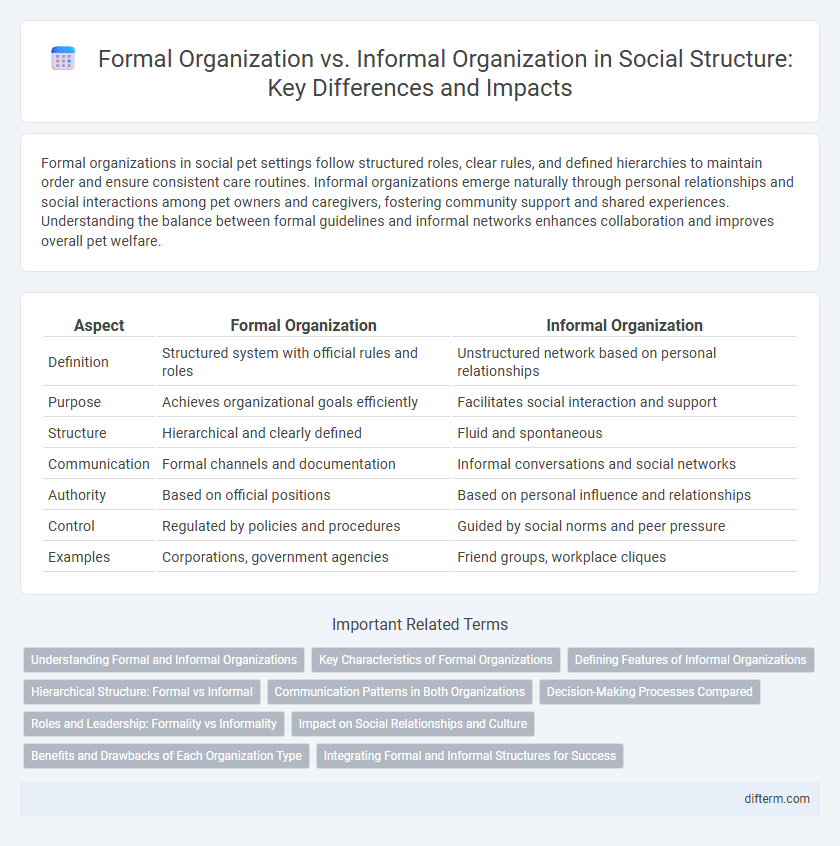Formal organizations in social pet settings follow structured roles, clear rules, and defined hierarchies to maintain order and ensure consistent care routines. Informal organizations emerge naturally through personal relationships and social interactions among pet owners and caregivers, fostering community support and shared experiences. Understanding the balance between formal guidelines and informal networks enhances collaboration and improves overall pet welfare.
Table of Comparison
| Aspect | Formal Organization | Informal Organization |
|---|---|---|
| Definition | Structured system with official rules and roles | Unstructured network based on personal relationships |
| Purpose | Achieves organizational goals efficiently | Facilitates social interaction and support |
| Structure | Hierarchical and clearly defined | Fluid and spontaneous |
| Communication | Formal channels and documentation | Informal conversations and social networks |
| Authority | Based on official positions | Based on personal influence and relationships |
| Control | Regulated by policies and procedures | Guided by social norms and peer pressure |
| Examples | Corporations, government agencies | Friend groups, workplace cliques |
Understanding Formal and Informal Organizations
Formal organizations are structured entities with defined roles, rules, and hierarchical systems designed to achieve specific goals. Informal organizations emerge naturally from social interactions among members, characterized by personal relationships and shared values that influence behavior beyond official protocols. Understanding the dynamics between formal and informal organizations helps in managing employee motivation, communication flow, and organizational culture effectively.
Key Characteristics of Formal Organizations
Formal organizations feature structured hierarchies with clearly defined roles and responsibilities to ensure efficiency and accountability. They operate under established rules, policies, and procedures designed to achieve specific goals and objectives. Communication is typically top-down, enabling coordination and control across all levels of the organization.
Defining Features of Informal Organizations
Informal organizations are characterized by spontaneous, non-structured relationships that naturally develop among individuals based on social interactions and personal affinities. These organizations lack official hierarchy and formal rules, relying instead on trust, shared norms, and common interests to guide behavior. Informal networks facilitate communication, foster collaboration, and influence workplace culture beyond the boundaries of formal organizational charts.
Hierarchical Structure: Formal vs Informal
Formal organizations feature a well-defined hierarchical structure with clear authority lines, roles, and responsibilities that establish order and accountability. Informal organizations operate through spontaneous, flexible networks of relationships that emerge naturally, often bypassing the official chain of command. Understanding the impact of hierarchical structure on communication and decision-making helps optimize organizational efficiency and employee satisfaction.
Communication Patterns in Both Organizations
Formal organizations utilize structured communication patterns with clear channels, such as official memos, meetings, and hierarchical reporting lines, ensuring information flows systematically. Informal organizations rely on spontaneous, social interactions and networks, enabling faster, more flexible communication that often bypasses formal protocols. Understanding these communication patterns is crucial for managing information dissemination and improving organizational effectiveness.
Decision-Making Processes Compared
Formal organizations rely on structured decision-making processes characterized by hierarchical authority and clearly defined roles, ensuring consistency and accountability. Informal organizations, driven by social networks and personal relationships, facilitate rapid and flexible decision-making often based on trust and consensus rather than formal rules. The interplay between formal protocols and informal dynamics significantly influences organizational effectiveness and responsiveness.
Roles and Leadership: Formality vs Informality
Formal organizations establish clearly defined roles and leadership structures based on official hierarchies and job descriptions, ensuring accountability and consistent decision-making. Informal organizations rely on social networks and personal influence, where leadership emerges naturally through trust and charisma rather than formal authority. This contrast affects communication flow, with formal structures emphasizing protocol and informal groups fostering flexibility and adaptability.
Impact on Social Relationships and Culture
Formal organizations establish structured roles and rules that shape predictable social interactions, promoting efficiency but often limiting personal connections. Informal organizations arise from spontaneous social networks, fostering trust, camaraderie, and cultural transmission beyond official hierarchies. The interplay between formal and informal structures significantly influences workplace culture, employee morale, and overall group cohesion.
Benefits and Drawbacks of Each Organization Type
Formal organizations provide clear structure and roles, enhancing efficiency and accountability but may limit flexibility and creativity in decision-making. Informal organizations foster strong interpersonal relationships and adaptability, promoting innovation and morale, yet they can lead to ambiguity in authority and inconsistent communication. Balancing formal rules with informal interactions is crucial for optimizing workplace dynamics and overall performance.
Integrating Formal and Informal Structures for Success
Integrating formal and informal organizational structures enhances overall workplace efficiency by aligning official protocols with social dynamics. Formal organizations provide clear roles and policies, while informal networks foster communication, trust, and collaboration among employees. Leveraging both structures promotes adaptability and innovation, driving sustained organizational success.
formal organization vs informal organization Infographic

 difterm.com
difterm.com